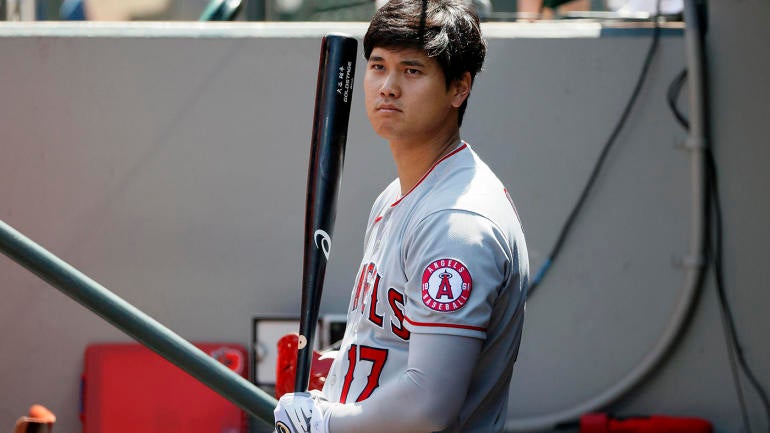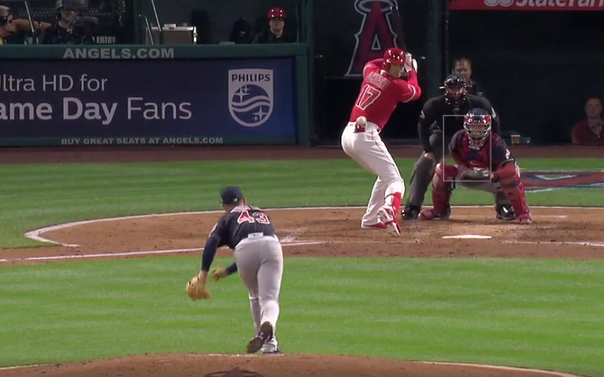
Bold, undaunted declaration: Shohei Ohtani has been the best power hitter in baseball this season.
The Angels' two-way starburst heads into the break -- and the Home Run Derby -- with an MLB-leading 33 home runs and an MLB-leading slugging percentage of .698. As well, Ohtani tops the majors in triples with four (in addition to his jaw-dropping power at the plate and his excellence on the mound, Ohtani also boasts elite speed).
To state the gloriously obvious, Ohtani's pitching contributions in tandem with his offensive outputs make him a singular force in today's game. It's that combination that has allowed Ohtani to keep an appointment with history on what seems like a nightly basis, and it's the latter -- i.e., his miracle-working with the bat -- that will be the focus on Monday night in Coors Field. Ohtani enters the 2021 Home Run Derby as the favorite (+300) to bookmakers and observers both casual and devoted. Given what Ohtani has become at the plate, that expectation is eminently defensible.
So as we wait for the show to begin, let's take a moment to look back at how and why Ohtani has developed into baseball's top power hitter of 2021. Come with us, won't you?
It all starts with a key adjustment
Late in Ohtani's first MLB spring training in 2018, he made a major mechanical change at the plate. At the urging of then-Angels hitting coach Eric Hinske, Ohtani abandoned the high leg kick at the plate that he'd used since high school and replaced it with a more subtle ankle turn. The change simplified his timing mechanism at the plate, but the turning action of his front foot still allowed Ohtani to get his lower half moving and achieve hip-shoulder separation.
Very likely, the change allowed him to adjust to the higher velocities and harder breaking stuff of MLB relative to NPB in Japan, where Ohtani spent the first five seasons of his professional career. Not surprisingly, Ohtani hasn't wavered since making the change. Take a look at his loading phase just prior to connecting for his first MLB home run, at the expense of a Josh Tomlin curveball, on April 3, 2018:

And now here's Ohtani moments before hitting his 32nd home run of this season, off an Eduardo Rodriguez changeup on July 7:

Maybe the hands are in a slightly different position these days, but that could also be the camera angle playing its tricks. Basically, it's the same setup. The hands are high, he's bent one click at the hips, and he's doing the ankle turn (or the toe tap, as some call it) in lieu of the exaggerated stride. It's hard to argue with the results, especially lately.
Consider the context
It makes sense that Ohtani might just be now finding his highest level as a hitter. First, there's his age. He was 23 at the time of his MLB debut, and at present he's 27. While players are tending to arrive at the highest level closer to peak form than they once did, it's still not unusual to see a hitter follow more of a traditional trajectory in which his peak comes at age 27 or 28 or thereabouts. That would describe Ohtani this season.
Ohtani also entered the 2021 season with fewer than 1,000 career plate appearances in MLB spread across three seasons, one of which was of course abbreviated and thrown off course by a global pandemic. Early in his career, he often trained his hitting erratically in order to accommodate his pitching. Typically he would do no hitting whatsoever on the day before he pitched in a game, the day he pitched, and the day after. Given that hitting against the best pitchers in the world is highly routine- and repetition-dependent, it follows that Ohtani might not have been able to reach his ceiling during that span. This year has been different, as Ohtani was regularly a DH when not on the mound, and he also batted in 10 of his 13 starts as a pitcher. Getting reps on a far more consistent basis has no doubt helped Ohtani in 2021.
All of this is to say nothing of the immense cultural, mental, and emotional challenges of playing baseball on the other side of the world.
He's finally healthy
Ohtani in his rookie MLB season of 2018 continued to hit despite a right elbow injury that would eventually require Tommy John surgery in October of that year. That's a pitching injury, yes, but having an elbow at the plate compromised to that extent will no doubt exact a toll on the numbers. In 2019, Ohtani didn't pitch, but even as he recovered from elbow surgery he logged 425 (productive) plate appearances. The safe assumption is that his healing elbow at least to some extent made his duties with the bat more difficult.
On top of all that, it wasn't until September 2019 that Ohtani underwent surgery to correct a congenital condition that in essence left him with not one but two kneecaps in his left knee (i.e., his drive leg at the plate and on the mound). Ohtani and the Angels weren't even aware of the condition until it turned up in a February 2019 MRI. "It's generally asymptomatic and generally has been asymptomatic in his career, but it's aggravated him a number of times throughout the season," then-Angels GM Billy Eppler said at the time of the surgery. "My understanding is that people who suffer from this condition have a patella that did not fuse at birth."
So there's further evidence that Ohtani for at least the first two seasons of his MLB career was operating in a compromised state. In 2021, however, Ohtani has been fully healthy, and an array of personal bests at the plate have ensued.
The numbers show the evolution
Underpinning the gaudy home-run totals are advanced pitch-recognition skills and an elite knack for finding the sweet spot. Consider how he's fared in the following fundamental indicators this season:
- Ohtani's current average exit velocity of 93.6 mph is in the top 3.0 percent of the league in 2021.
- Ohtani's max exit velocity of 119 mph this season is in the top 1.0 percent of the league.
- His hard-hit rate of 56.7 percent is in the top 2.0 percent of the league.
- His rate of "barrels," or how often he hits the ball with ideal combination of exit velocity and launch angle, is 25.9 percent. That's in the top 1.0 percent of the league.
In terms of his career trajectory, know that all of those figures above constitute career bests for Ohtani. One key for Ohtani when it comes to unlocking his power potential has been his launch angle, or the angle at which the ball leaves the hitter's bat. Here are how Ohtani's average launch angles have tracked throughout his MLB career:
| Season | Ohtani's launch angle, in degrees |
|---|---|
2018 | 12.3 |
2019 | 6.8 |
2020 | 9.2 |
2021 | 17.8 |
The ideal launch angle for hitting for power is between 15 and 20 degrees, generally speaking, and as you can see Ohtani is squarely within that range this season. Some hitters achieve a more optimal launch angle by overhauling their mechanics. Others achieve it by improving their ability to get on plane with the pitch within the confines of their existing swing. The latter appears to be the case with Ohtani. That brings us back to health, consistent playing time, and mounting experience as an MLB hitter.
In matters related, Ohtani this season has a fly ball percentage of 35.3. His previous career-high in that measurement was 24.0 in 2018. When you hit the ball as hard as Ohtani does, you want to hit it in the air, and he's doing that more than ever now.
Not surprisingly, pitchers are attacking the zone less than ever against Ohtani, which is the rational response to a hitter who has 56 extra-base hits in 84 games. Ohtani, however, isn't playing along. He's swinging at strikes at career-best rates, but his chase rate -- i.e., how often he swings at pitches outside the zone -- is a bit below career norms. Ohtani's more aggressive than the average hitter, but it's a properly harnessed aggressiveness in most instances.
If there's a metrical bottom line to all of this, it's found in Ohtani's expected slugging percentage, which puts a figure on what his slugging percentage ought to be based on things like quality of contact. His expected slugging percentage right now is .711, which is the highest in all baseball by a wide margin. In other words, Ohtani has actually been a bit unlucky this season to be slugging "just" .698 at the break. Chew on that particular flavor of cud for a moment.
The inside pitch
During Ohtani's lackluster 2020 season, Angels manager Joe Maddon on a couple of occasions noted his slugger's struggles with inside pitches. Maddon early in the current season, however, noted that Ohtani appeared to have addressed that particular deficiency. Have a glance at his slugging percentages on inside pitches last season:

Versus this season:

We see that, yes, Ohtani is indeed hitting inside pitches with authority, especially relative to what he was able to do in 2020. That's something else that's contributed to his stratospheric power production in 2021.
Add it all up, and Ohtani's journey from goodness to greatness at the plate isn't hard to explain. That journey is also why Ohtani will very likely continue producing at these levels, at least in the near- to mid-term.
Note that "near- to mid-term" is a span that absolutely includes Monday night in Coors Field.


















